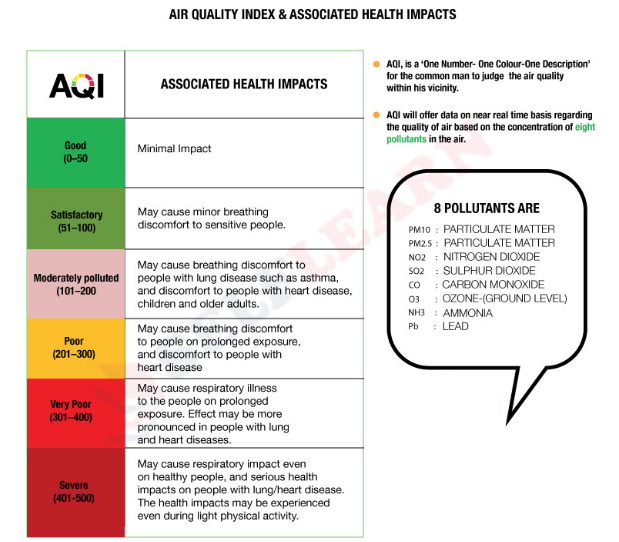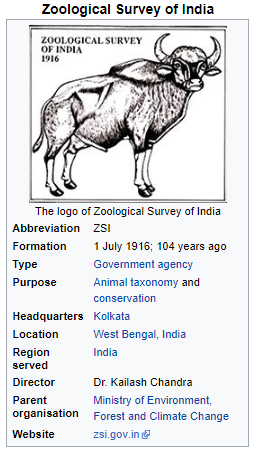Static Quiz 13 May 2022
Quiz-summary
0 of 5 questions completed
Questions:
- 1
- 2
- 3
- 4
- 5
Information
Static Quiz 13 May 2022 for UPSC Prelims
You have already completed the quiz before. Hence you can not start it again.
Quiz is loading...
You must sign in or sign up to start the quiz.
You have to finish following quiz, to start this quiz:
Results
0 of 5 questions answered correctly
Your time:
Time has elapsed
You have reached 0 of 0 points, (0)
Categories
- Not categorized 0%
- 1
- 2
- 3
- 4
- 5
- Answered
- Review
- Question 1 of 5
1. Question
Which of the following are the effects of smog?
1. It hampers visibility and harms the environment.
2. Respiratory problems
3. Deaths relating to bronchial diseases.CorrectAns;- d) All of the above
Explanation;-
• The effects of smog
1. It hampers visibility and harms the environment.
2. respiratory problems
3. deaths relating to bronchial diseases.
4. Heavy smog greatly decreases ultraviolet radiation.
5. Heavy smog results in the decrease of natural vitamin D production leading to a rise in the cases of rickets.IncorrectAns;- d) All of the above
Explanation;-
• The effects of smog
1. It hampers visibility and harms the environment.
2. respiratory problems
3. deaths relating to bronchial diseases.
4. Heavy smog greatly decreases ultraviolet radiation.
5. Heavy smog results in the decrease of natural vitamin D production leading to a rise in the cases of rickets. - Question 2 of 5
2. Question
Which of the following statements regarding National Air Quality Monitoring Programme (NAMP) are correct?
1. In India, the National Green Tribunal (NGT) has been executing a nationwide programme of ambient air quality monitoring known as National Air Quality Monitoring Programme (NAMP).
2. The NAMP is to determine status and trends of ambient air qualityCorrectAns;- b) Only 2
Explanation;-
• The CPCB has been executing a nationwide programme of ambient air quality monitoring known as National Air Quality Monitoring Programme (NAMP) not NGT.
National Air Quality Monitoring Programme
• In India, the Central Pollution Control Board (CPCB) has been executing a nationwide programme of ambient air quality monitoring known as National Air Quality Monitoring Programme (NAMP).
• The National Air Quality Monitoring Programme (NAMP) is undertaken in India
• to determine status and trends of ambient air quality
• to ascertain the compliance of NAAQS
• to identify non-attainment cities
• to understand the natural process of cleaning in the atmosphere; and
• to undertake preventive and corrective measures.
• Annual average concentration of SOx levels are within the prescribed National Ambient Air Quality Standards (NAAQS).IncorrectAns;- b) Only 2
Explanation;-
• The CPCB has been executing a nationwide programme of ambient air quality monitoring known as National Air Quality Monitoring Programme (NAMP) not NGT.
National Air Quality Monitoring Programme
• In India, the Central Pollution Control Board (CPCB) has been executing a nationwide programme of ambient air quality monitoring known as National Air Quality Monitoring Programme (NAMP).
• The National Air Quality Monitoring Programme (NAMP) is undertaken in India
• to determine status and trends of ambient air quality
• to ascertain the compliance of NAAQS
• to identify non-attainment cities
• to understand the natural process of cleaning in the atmosphere; and
• to undertake preventive and corrective measures.
• Annual average concentration of SOx levels are within the prescribed National Ambient Air Quality Standards (NAAQS). - Question 3 of 5
3. Question
Which of the following statements regarding National Ambient Air Quality Standards (NAAQS) are correct?
1. National Ambient Air Quality Standards (NAAQS) were notified in the year 1982, duly revised in 1994 based on health criteria and land uses.
2. The NAAQS have been revisited and revised in November 2009 for 12 pollutants.CorrectAns;- c) Both 1 and 2
Explanation;-
• Both the statements are correct regarding NAAQS.
• National Ambient Air Quality Standards (NAAQS) were notified in the year 1982, duly revised in 1994 based on health criteria and land uses.
• The NAAQS have been revisited and revised in November 2009 for 12 pollutants, which include
• sulphur dioxide (SO2),
• nitrogen dioxide (NO2),
• particulate matter having size less than 10 micron (PM10),
• particulate matter having size less than 2.5 micron (PM2.5),
• ozone,
• lead,
• carbon monoxide (CO),
• arsenic,
• nickel,
• benzene,
• ammonia, and
• BenzopyreneIncorrectAns;- c) Both 1 and 2
Explanation;-
• Both the statements are correct regarding NAAQS.
• National Ambient Air Quality Standards (NAAQS) were notified in the year 1982, duly revised in 1994 based on health criteria and land uses.
• The NAAQS have been revisited and revised in November 2009 for 12 pollutants, which include
• sulphur dioxide (SO2),
• nitrogen dioxide (NO2),
• particulate matter having size less than 10 micron (PM10),
• particulate matter having size less than 2.5 micron (PM2.5),
• ozone,
• lead,
• carbon monoxide (CO),
• arsenic,
• nickel,
• benzene,
• ammonia, and
• Benzopyrene - Question 4 of 5
4. Question
Which of the following statements regarding National Air Quality Index (NAQI) are correct?
1. National Air Quality Index was launched by the Prime Minister in April, 2015
2. The AQI has six categories of air quality, viz Good, Satisfactory, Moderately Polluted, Poor, Very Poor and Severe with distinct colour scheme.CorrectAns;- c) Both 1 and 2
Explanation;-
• Both the statements are correct.
• National Air Quality Index was launched by the Prime Minister in April, 2015 starting with 14 cities to disseminate air quality information.
• The AQI has six categories of air quality, viz Good, Satisfactory, Moderately Polluted, Poor, Very Poor and Severe with distinct colour scheme. Each of these categories is associated with likely health impacts.
• AQI considers eight pollutants (PM10, PM 2.5, NO2, SO2, CO, O3, NH3 and Pb) for which (up to 24-hourly averaging period) National Ambient Air Quality Standards are prescribed. Incorrect
IncorrectAns;- c) Both 1 and 2
Explanation;-
• Both the statements are correct.
• National Air Quality Index was launched by the Prime Minister in April, 2015 starting with 14 cities to disseminate air quality information.
• The AQI has six categories of air quality, viz Good, Satisfactory, Moderately Polluted, Poor, Very Poor and Severe with distinct colour scheme. Each of these categories is associated with likely health impacts.
• AQI considers eight pollutants (PM10, PM 2.5, NO2, SO2, CO, O3, NH3 and Pb) for which (up to 24-hourly averaging period) National Ambient Air Quality Standards are prescribed.
- Question 5 of 5
5. Question
Which of the following statements regarding Zoological Survey of India are correct?
1. Zoological Survey of India (ZSI) was established on 1st July 1916 to promote the survey, exploration, research and documentation leading to the advancement in our knowledge on various aspects of animal taxonomy of the Indian subcontinent.
2. ZSI is a premier institution on animal taxonomy in India under the Ministry of Environment, Forest and Climate Change.CorrectAns;- c) Both 1 and 2
Explanation;-
• Both the statements are correct.
• Zoological Survey of India (ZSI) was established on 1st July 1916 to promote the survey, exploration, research and documentation leading to the advancement in our knowledge on various aspects of animal taxonomy of the Indian subcontinent.
• ZSI is a premier institution on animal taxonomy in India under the Ministry of Environment, Forest and Climate Change. ZSI has been declared as the designated repository for the National Zoological Collection as per Section 39 of the National Biodiversity Act, 2002. Incorrect
IncorrectAns;- c) Both 1 and 2
Explanation;-
• Both the statements are correct.
• Zoological Survey of India (ZSI) was established on 1st July 1916 to promote the survey, exploration, research and documentation leading to the advancement in our knowledge on various aspects of animal taxonomy of the Indian subcontinent.
• ZSI is a premier institution on animal taxonomy in India under the Ministry of Environment, Forest and Climate Change. ZSI has been declared as the designated repository for the National Zoological Collection as per Section 39 of the National Biodiversity Act, 2002.





